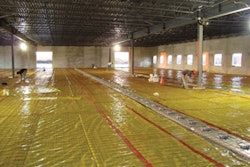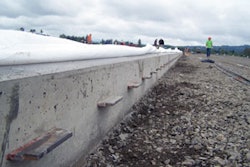BOSTON--(BUSINESS WIRE)-- Cement and concrete for decades have been regarded as the antithesis of all that's green and growing, which is no surprise. The building and construction industry uses about 2.9 billion tonnes of cement and 30 billion tonnes of concrete every year, making them civilization's most widely used substances after water. Further, production and use of all that material results in 2 billion tonnes of carbon output every year - about 6% of all human-generated CO2 emissions. In its latest report, Lux Research assesses the expanding field of technologies aimed at making concrete greener through improved production techniques, advanced additives, alternative materials, and innovative applications.
Titled "Paving the Way to Cost, Energy, and Carbon Savings in the Concrete Industry," the report evaluates which technologies are most likely to capture a significant share of the market. To do this, it scores technologies according to 14 criteria and plots them on a visually intuitive grid that allows readers to compare them by technical value and probability of adoption. In addition to analysis of the overall market, the report drills down into four market segments: improvements to Portland cement production, Portland cement replacement additives, alternative cementing materials, and building energy efficiency and performance technologies.
"Reducing concrete's carbon footprint doesn't drive adoption of these technologies so much as reducing the energy costs associated with concrete's production and use," said Oliver Tassinari, an analyst for Lux Research and the report's lead author. "That said, support for 'sustainable buildings' is growing among policymakers, architects, engineers, and building material firms. Existing and slated government regulations and incentives are likely to accelerate adoption."
The report builds on extensive research compiled by the Lux Green Buildings Intelligence service, as well as multiple interviews of technology developers, chemical companies, cement producers and construction firms. Among its key findings:
Incremental improvements make the most headway. Technologies that improve current Portland cement production came out on top in the analysis because they require minimal change on the part of cement manufacturers, engineers, and builders alike. Technologies that fit this category include migrating production to the "dry" process, use of heat recovery, and alternative and waste fuels, and further use of fly ash and slag. In all, they have the potential to reduce energy consumption by up to 65%, and reduce CO2 emissions by up to 60%. Disruptive alternative cementitious materials fail to catch on. Most low-CO2 alternative cementitious materials - including those that use flue gas to precipitate materials and those that switch out Portland cement for alternative cementitious materials - are still in the early stages of development. They are unproven, uncertified, and often require proximity to CO2 sources and seawater. Furthermore, they impose high capital requirements, and make little economic sense without substantial global carbon pricing or regulation. Innovative use of concrete leads to energy savings in buildings. The implementation of technologies like insulating concrete forms and aerated concrete has been slow due to high upfront cost and poor availability. However, adoption should increase as providers demonstrate energy savings upwards of 30% on heating and cooling loads. Additional technologies offer improved durability and strength of concrete, which will greatly reduce maintenance costs and the need for retrofits in the middle of a building's life.
"Paving the Way to Cost, Energy, and Carbon Savings in the Concrete Industry," is part of the Lux Green Buildings Intelligence service. Clients subscribing to this service receive ongoing research on market and technology trends, continuous technology scouting reports and proprietary data points in the weekly Lux Research Green Buildings Journal, and on-demand inquiry with Lux Research analysts.
About Lux Research
Lux Research provides strategic advice and on-going intelligence for emerging technologies. Leaders in business, finance and government rely on us to help them make informed strategic decisions. Through our unique research approach focused on primary research and our extensive global network, we deliver insight, connections and competitive advantage to our clients. Visit www.luxresearchinc.com for more information.
Lux Research, Inc. Carole Jacques, 617-502-5314 [email protected]
Source: Lux Research
<


















